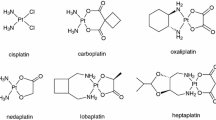Abstract
The antitumor activity of a novel synthetic chalcone derivative, 2′-hydroxy-2,4,6′-trimethoxychalcone (1H3MC), was evaluated using the multi-drug-resistant human uterine sarcoma MES-SA/Dx5 cells. Treatment with 1H3MC reduced P-glycoprotein expression in a time-dependent manner and inhibited MES-SA/Dx5 cell proliferation. Cisplatin alone had no effect on cell viability, but combined treatment with cisplatin and 1H3MC exhibited synergistic cytotoxicity. Furthermore, the combination of cisplatin and 1H3MC synergistically cleaved both caspase-3 and its substrate protein, poly(ADP-ribose) polymerase, which resulted in the fragmentation of genomic DNA, a hallmark of apoptosis. These results suggest that 1H3MC is a promising adjuvant agent for overcoming P-glycoprotein-mediated multi-drug resistance in cancer cells.



Similar content being viewed by others
References
Boumendjel A, Di Pietro A, Dumontet C, Barron D (2002) Recent advances in the discovery of flavonoids and analogs with high-affinity binding to P-glycoprotein responsible for cancer cell multidrug resistance. Med Res Rev 22:512–529
Danial NN, Korsmeyer SJ (2004) Cell death: critical control points. Cell 116:205–219
Gottesman MM, Pastan I (1993) Biochemistry of multidrug resistance mediated by the multidrug transporter. Annu Rev Biochem 62:385–427
Kartner N, Riordan JR, Ling V (1983) Cell surface P-glycoprotein associated with multidrug resistance in mammalian cell lines. Science 221:1285–1288
Kuo MT, Liu Z, Wei Y, Lin-Lee YC, Tatebe S, Mills GB, Unate H (2002) Induction of human MDR1 gene expression by 2-acetylaminofluorene is mediated by effectors of the phosphoinositide 3-kinase pathway that activate NF-kappaB signaling. Oncogene 21:1945–1954
Lee YH, Jeon SH, Kim SH, Kim C, Lee SJ, Koh D, Lim Y, Ha K, Shin SY (2012) A new synthetic chalcone derivative, 2-hydroxy-3’,5,5’-trimethoxychalcone (DK-139), suppresses the Toll-like receptor 4-mediated inflammatory response through inhibition of the Akt/NF-kappaB pathway in BV2 microglial cells. Exp Mol Med 44:369–377
Liu XL, Tee HW, Go ML (2008) Functionalized chalcones as selective inhibitors of P-glycoprotein and breast cancer resistance protein. Bioorg Med Chem 16:171–180
Loo TW, Clarke DM (2008) Mutational analysis of ABC proteins. Arch Biochem Biophys 476:51–64
Parveen Z, Brunhofer G, Jabeen I, Erker T, Chiba P, Ecker GF (2014) Synthesis, biological evaluation and 3D-QSAR studies of new chalcone derivatives as inhibitors of human P-glycoprotein. Bioorg Med Chem 22:2311–2319
Prasad S, Phromnoi K, Yadav VR, Chaturvedi MM, Aggarwal BB (2010) Targeting inflammatory pathways by flavonoids for prevention and treatment of cancer. Planta Med 76:1044–1063
Ross JA, Kasum CM (2002) Dietary flavonoids: bioavailability, metabolic effects, and safety. Annu Rev Nutr 22:19–34
Ruth Devakaram DSB, Kumar N (2010) An efficient synthesis of novel tetrahydrochromeno[2,3-b]chromenes. Tetrahedron Lett 51:3636–3638
Shin SY, Kim JH, Yoon H, Choi YK, Koh D, Lim Y, Lee YH (2013) Novel Antimitotic Activity of 2-Hydroxy-4-methoxy-2’,3’-benzochalcone (HymnPro) through the inhibition of tubulin polymerization. J Agric Food Chem 61:12588–12597
Wesolowska O, Paprocka M, Kozlak J, Motohashi N, Dus D, Michalak K (2005) Human sarcoma cell lines MES-SA and MES-SA/Dx5 as a model for multidrug resistance modulators screening. Anticancer Res 25:383–389
Yadav VR, Prasad S, Sung B, Aggarwal BB (2011) The role of chalcones in suppression of NF-kappaB-mediated inflammation and cancer. Int Immunopharmacol 11:295–309
Zhang EH, Wang RF, Guo SZ, Liu B (2013) An update on antitumor activity of naturally occurring chalcones. Evid Based Complement Altern Med 2013:815621
Acknowledgments
This paper resulted from the Konkuk University research support program.
Author information
Authors and Affiliations
Corresponding author
Rights and permissions
About this article
Cite this article
Shin, S.Y., Lee, M.S., Lee, D.H. et al. The synthetic compound 2′-hydroxy-2,4,6′-trimethoxychalcone overcomes P-glycoprotein-mediated multi-drug resistance in drug-resistant uterine sarcoma MES-SA/DX5 cells. J Korean Soc Appl Biol Chem 58, 105–109 (2015). https://doi.org/10.1007/s13765-015-0017-y
Received:
Accepted:
Published:
Issue Date:
DOI: https://doi.org/10.1007/s13765-015-0017-y




